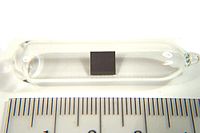
Photo from wikipedia
A radiological evaluation associated to the future mining of grey monazite nodules enriched in light rare-earths, from a modest superficial deposit located in the centre of Spain, has been performed… Click to show full abstract
A radiological evaluation associated to the future mining of grey monazite nodules enriched in light rare-earths, from a modest superficial deposit located in the centre of Spain, has been performed at pre-operational level, and the main results are shown in this paper. Although the monazite nodules in the deposit are clearly enriched in radionuclides from the uranium and thorium series with activity concentrations higher than 1 Bq/g, the size of these nodules (in the 0.5 mm-2 mm grain size interval), its refractory behaviour that prevents the leaching or dissemination of natural radionuclides to waters or other ecosystem compartments and consequently the impact in the food chain, and its presence quite diluted in the deposit at concentrations of 2.5-3 kg/m3, conducted to conclude that pre-operationally the area to be mined for the extraction of the monazite is generating a negligible radiological impact in the public and the nearby environment. Additionally, the extraction of the raw material and the restoration of the area after mining (i.e. the mining activities which will be done in-situ, in the mining area) will be exempted of any radiological regulation attending to the European Union legislation being expected that will not generate a radiological impact.
Journal Title: Chemosphere
Year Published: 2018
Link to full text (if available)
Share on Social Media: Sign Up to like & get
recommendations!